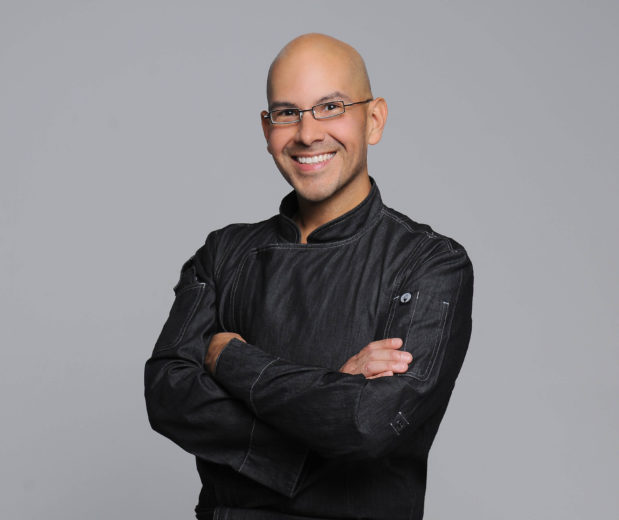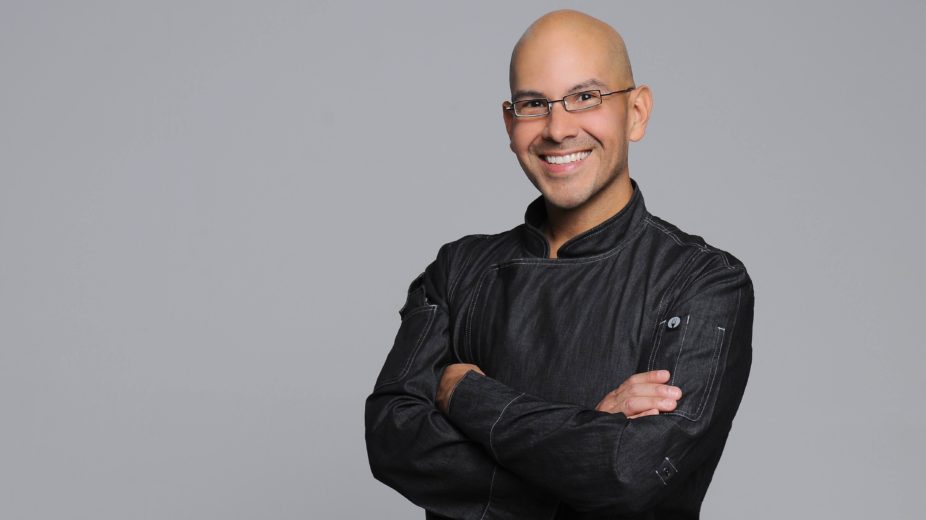
Eddie Garza is on his second act in life. The vegan chef went from being a professional musician and teacher to a celebrity chef and public speaker who’s using food to change the world. He’s gone from teaching scales to teaching people how to eat food that’s good for them and the world they live in.
The 42 year-old Mexican American has taken his culinary secrets and re-imagined Mexican food as vegan fare. In his new book, Salud! Mexican Vegan Cookbook, Garza shares 150 plant-powered recipes including favorites like flautas and burritos as well as fideos and moyetes (open-faced sandwiches).
His food is so good that he has been a private chef for Latino celebrities including Marco Antonio Regil, Ximena Córdoba, and Catalina Robayo. Garza has shared his ideas about food in schools and large conferences like South by Southwest in Austin and ExpoSer in Mexico City.
We spoke to Garza about life before and after going vegan, power plants and why Mexican food is vegan food hiding in plain sight.
‘LLERO: Tell us about how and why you went vegan?
Chef Garza: I went vegan when I was 21 years old. I weighed 310 lbs and I’m 5’7”. Morbidly obesity at that point. I had constant sprained ankles because of my obesity and couldn’t walk. [I was a musician and teacher at the time] and one year on the first day of classes [a new teacher] said “Dude you’re fat!” She said it so bluntly like she was in shock. I turned beet red and started sweating. She said ‘Join me this weekend. I’m going to this meeting to learn how to lose weight.” So I did. We were in AA for food. I learned about eating and health and together we made this big lifestyle change.
I also learned about the environmental impact of agriculture. Diet is the most important and impactful way to help. At this time I started meeting more people involved in this work for ethical reasons and saw how animals were treated. It all came full circle. It started with health, then empathy towards all animals and now knowing I’m being a champion for the environment.
‘LL: For those who don’t know tell us what being vegan is.
CG: To be vegan, at least in food world, means not consuming animal products: meat, dairy, eggs, anything that comes from an animal including honey from bees. My kitchen is completely animal free.
‘LL: How and why did you switch careers?
CG: I’ve been cooking as long as I can remember. It was one of the first things I knew I wanted to do. When I was 7 years old, my mom was sick so I made her breakfast in bed, French crepes. I knew at that point, ‘This is my calling.’ My lifestyle change prompted my career change. I went to study with a chef in Dallas at the Spiral Diner. The only established vegan restaurant where I was living. I went back to myself as a chef. Applied all the tricks I learned to my Mexican kitchen. That’s when I really found my identity. Less than a year in, I branched out on my own. I started out as a private chef and it was really word of mouth from there.
‘LL: What was life like before you became a vegan?
CG: I was on the pathway to becoming obese when I left my hometown of Brownsville, Texas. It really got bad when I moved to Dallas area. I was living a volatile lifestyle. Early in the morning, I would get up to teach and I would have a triple cheeseburger for breakfast before my first class of day. I wouldn’t eat again until end of school. Go for another triple cheeseburger or other fast food at night. Wake up and do the same thing over again. I didn’t know any better or how else to do life.
‘LL: You have said that growing up in Texas obesity and health issues were the norm. How has your family responded to your experience with veganism?
CG: I think the word “vegan” took some explaining but it didn’t take much understanding of what it was. The way I explained it to my mom was, “I eat the way we eat during Lent (no meat) on Friday.” It was like “ohhh!” A few years later my brother ended up going vegan to control his psoriases. [It’s not a new idea because] A lot of the food in Central Mexico where my family is from is naturally plant based.
‘LL: What food or dish did you change the most (ingredient wise) that still has the same taste to it?
CG: Definitely my Bandeja Paisa. It’s a Colombian dish from Antioquia. [It is ] considered the national dish of Colombia. Traditionally it includes ground beef, a large sausage, eggs, chicharron (pork rind), rice, beans, plantains and avocado. For my vegan version, I replaced the ground beef with ground seitan (“wheat meat”), the sausage with a lentil-seitan blend, the eggs with a silken tofu scramble and the chicharron with seasoned tofu fillets. Last year I took my vegan bandeja paisa on tour to Colombia (in Bogotá and Medellín) and everybody was blown away by the incredible similarities between my vegan version and the traditional meaty version.
‘LL: With ideas about food changing you released Salud! Vegan Mexican Cookbook, at the right time. Tell us about it.
CG: It features all the foods I grew up eating. It has 150 recipes that represent the pounds I lost going vegan. I wrote it with my grandmother in mind. She taught me everything about Mexican flavors. Part of why I wanted to write the book, was to document and answer what exactly [ goes into those recipes]. There are so many questions about how do you do this, get the perfect flavors, how much does a cubito actually weigh? The book features all of those things.
It includes the standard Mexican food you know like enchiladas, flautas, tamales plus super mountain foods like la coche, a mushroom that grows on corn and has more protein than beef. I wanted to bring that flavor of Central Mexico to the US.
‘LL: What is a “plant powered recipe”?
CG: If we think about energy we need in a day, I call it plant powered because things like chick peas or lentils, that’s a plant powerful food. It has the carbs you need to do cardio, but enough protein to be considered good after a workout. It’s a super food, High energy carb and also protein powered. It’s incredible to see what plants can do for your body. They provide high-benefits for a low amount of calories.
‘LL: How can you preserve your culture and be vegan?
CG: I feel like my Mexican culture really lends itself to the vegan lifestyle. So much of the original foods of Mexico are either vegan naturally or super vegan-friendly. And if you really think about it, all the flavors of modern Mexican cuisine come from plants. If you apply all the same herbs, spices, chiles and vegetable bases to plant-based proteins, you end up with the same dynamic flavors of Mexico.
‘LL: Any advice for potential vegans?
CG: A lot of people start this lifestyle but don’t know how to do or how to bring flavor. I hear over and over “I hate salads.” I do too! So many people think it’s eating lettuce. That’s the thing if you really want to know it can be like in a flavorful way, do it Mexican. It’s the number one food trend because it’s delicious and amazing.
Follow Eddie Garza and his vegan food and travel adventures on Instagram @theeddiegarza

